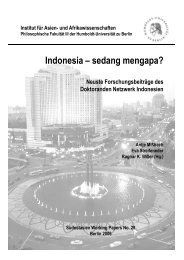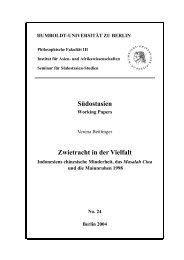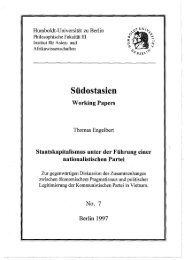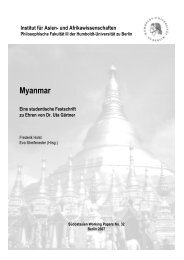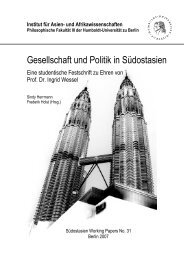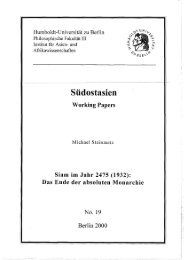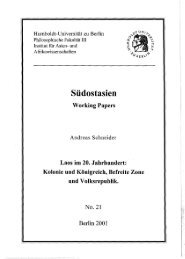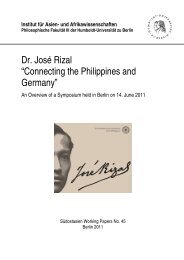When violence broke out in Maluku in January 1999, the DDII quickly demonstrated its concern overthe situation of Muslims in Ambon and conducted humanitarian activities utilizing the support frominternational philanthropic organizations. 102 The group also published the first bulletin that specificallycovered the Moluccan conflict. Rumours related to the RMS claimed that remaining forces of thisrebellious movement, supported by their Netherlands-based international sponsor, deliberately instigatedthe conflict under the collaboration of the Moluccan Protestant Church and Megawati’s party inan effort to set up a Christian state in the Moluccas 103 This rumour was very early countered by theMaluku police chief, stating on February 3, 1999, via the Indonesian TVRI television network thatreports of people flying the RMS flag at several occasions were misleading. “The rumours on RMSflags have been spreading among us here and have been causing confusion (...): There were no RMSflags (...) there are no RMS activities either”. 104The conspiracy theory appeared first on the national level on 28 January 1999, during a press conferenceorganized by two hard-line Muslim groups, the Indonesian Committee for the Solidarity of theMuslim World (KISDI) and the Indonesian Muslim Workers Union (PPMI). 105 “The theory then spreadlike a bush fire as it was disseminated by the Muslim controlled media in Indonesia, where the abbreviationof ‘RMS’ became distorted to mean ‘Christian Moluccan Republic’, denying the fact thatAmbonese Muslims had also taken part in founding this liberation movement whose goal was not toset up a Christian state”. 106An important figure in linking the Maluku violence, an apparent revival of the RMS and Megawati’ssupport was (Ret). Brig.-Gen. Rustam Kastor. He published the ‘Christian-Western-RMS’ conspiracyin 2000. The book became a bestseller among Muslims in Maluku, Java and Sulawesi. 107 It blamed thestudent demonstrations in November 1998 in Ambon for preparing the ground for the so-called ‘RMSledMuslim-cleansing operation’ as a conscious attempt to weaken the military so that they would notbe able to crush the subsequent ‘RMS-led rebellion’ which aimed at cleansing Maluku from its Muslimpopulation”. 108 Kastor justified jihad fighting in Maluku and accused Megawati to support theRMS independence movement. 109 He claimed that Christians promoted Indonesia’s disintegration byseparating the Christian-dominated provinces of East Timor and Maluku to establish a new Christianstate with fantastic resources. 110The RMS conspiracy theory was given resonance in line with the articulation of the anti-Christian discourseof a Western conspiracy seeking to destroy Islam and the Muslim umma in Indonesia. SeveralIslamist media rigorously responded to the story by publishing articles portraying the Maluku conflictas a part of the Zionist-cum-Christian conspiracy to Christianize Muslims in the Moluccas, through thehands of the RMS. 111 Since the first months of the conflict, the magazine Sabili had published provokingheadlines. In its March 1999 issue, it underscored the role of Jews and Christians behind theconflict who were allegedly planning to cleanse Muslims from the Moluccas, under the headline“Moslem Cleansing: Ambon is not alone”. 112 The DDII blamed the Zionist-cum-Christian conspiracy102 Hasan, The radical Muslims discourse, 47.103 Hasan, The radical Muslims discourse, 5.104TVRI television network Jakarta, 03.02.1999: Maluku police chief dismisses reports on South Maluku Republic flags.BBC Summary of World Broadcasts.105 Aditjondro Guns, Pamphlets and Handie-Talkies, 115.106 Aditjondro, Guns, Pamphlets and Handie-Talkies, 115. HRW, The Violence in Ambon, 13.107 Aditjondro, Guns, Pamphlets and Handie-Talkies, 116. Hasan, The Radical Muslim Discourse.108 Aditjondro, Guns, Pamphlets and Handie-Talkies, 115.109 Aditjondro, Guns, Pamphlets and Handie-Talkies, 115.110 Aditjondro, Guns, Pamphlets and Handie-Talkies, 115.111Aditjondro, Guns, Pamphlets and Handie-Talkies, 115.112 Sabili, 24 March 1999: 14-18. Cited in: Hasan, The Radical Muslims Discourse, 628
to be behind the conflict and called for a jihad in December 1999 to respond to ‘a crusade waged byChristians’ with the headline “Jihad War is continuing in Ambon”. 113 Another publication equallysought to popularize this Zionist-cum-Christian conspiracy theory by headlines such as “Uncover thePractice of the GGG: Gold-Glory-Gospel: The Moslem Cleansing in Ambon”. 114 The attention ofIndonesian Muslims to the conflict increased as the discourse spread.The Pivotal “Bloody Christmas” MassacreViolence continued in Ambon as a reaction to the outbreak of violence in North Maluku in August1999 115 116 and dramatically increased during December 1999. President Wahid and Vice-PresidentMegawati visited the province in December and issued a joint appeal for peace to the population. Theydismissed the circulating conspiracy theory of a Christian separatist movement that provoked the conflict.117 On 24 December 1999, the Association of the Maluku Community in Makassar, a multireligiousbody with some 300 members, demanded the authorities to declare another ceasefire inMaluku to end the violence. It worked out peace proposals that were sent to the minister of religiousaffairs. 118Two days after the latest peacemaking efforts, the “Bloody Christmas”-massacre was committed on 26December 1999 in North Maluku. 119 The massacre of 400 to 500 Muslims was widely covered in theIndonesian press. It became pivotal in that it allowed Laskar Jihad to gain a stage. The Crisis Groupstates that local Christians went on the offensive against the local Moslem minority Tobelo, and atleast 500 Moslems were killed. 120 On the contrary, Aditjondro argues that the massacres were perpetratedby military troops who had previously disappeared in Maluku. He claims that precisely the sameweapons found in the hands of civilians that were owned by the rest of the troops still on duty. 121Hefner also states that eyewitnesses reported that trucks with men armed with automatic weaponsmade their way up to the Muslims settlements in an overwhelmingly Christian area. 122 The residentswere butchered with machetes, shot or burned alive in their houses. About 250, mostly women and113 Media Dakwah December 1999: 42-44. Cited in Hasan, The Radical Muslims Discourse, 6.114 Suara Hidayatullah, October 1999. Cited in Hasan, The Radical Muslims Discourse, 6.115 ICG, Overcoming Murder and Chaos in Maluku, 6.116The Indonesian government had approved the creation of the new province of North Maluku under its policy of decentralizationand therefore split Maluku into two provinces: Maluku and North Maluku. The Makianese, a Muslim migrantcommunity, hoped to create their own administrative district in the new province that would subsume five ethnic-Kao villages.The new district would have enormously benefited from the revenue of a gold mine in the area. Thus, the decisionabout the Makianese district would have had large financial consequences. Since February 1999, the Kao had stronglyand vocally opposed the plan and warned that blood would be spilled, but were largely ignored in the negotiations.North Maluku had seen long-standing competition between supporters of the traditional sultanates of Ternate and Tidore,the two small islands on Halmahera’s West coast that dominated the spice trade 200 years ago. Though both islands areabout 80 per cent Muslim, the Ternate sultan sided with the predominantly Christian Kao tribe on Halmahera Tidore sidedwith the Muslim Makianese. Thus, this rivalry underpinned the conflict in North Maluku. In spite of these complex localissues and tensions, the violence was quickly subsumed under the label “religious violence” that had already been acceptedfor the violence in Ambon and the surroundings. See Olle Törnquist (ed) Political Violence: Indonesia and India inComparative Perspective. SUM Report No.9; ICG, Overcoming Murder and Chaos in Maluku.117The Jakarta Post, 13.12.1999: Gus Dur calls for peace in Maluku.118The Jakarta Post, 19.12.1999: Group demands end to Maluku clashes.119 ICG, Overcoming Murder and Chaos in Maluku, 8120 ICG, Overcoming Murder and Chaos in Maluku, 16.121 George Aditjondro, Maluku: While Elephants fight, the people of Maluku die. In: Asia-Pacific Network: 27 January 2000http://www.asiapac.org.fj/cafepacific/resources/aspac/maluku.html, last accessed 10.02.2008.122 Robert W. Hefner (2000) Disintegration or Democratization? Muslim-Christian Violence and the Future of Indonesia. In:Törnquist (ed) Political Violence: Indonesia and India in Comparative Perspective, SUM Report No.9.29
- Seite 1: Institut für Asien- und Afrikawiss
- Seite 4 und 5: SÜDOSTASIEN Working PapersISSN: 14
- Seite 7: VorwortBoryano Rickum und Eva Strei
- Seite 10 und 11: Theoretischer Zugang: Waldschutzkon
- Seite 12 und 13: Zum anderen ist ein weiteres Proble
- Seite 14 und 15: verbleiben die Landrechte beim Staa
- Seite 16 und 17: Dutschke, Michael/Wolf, Reinhard (2
- Seite 18 und 19: Many commentators perceive religion
- Seite 20 und 21: in Maluku was “basically not a re
- Seite 22 und 23: around Wahid’s NU, Megawati’s n
- Seite 24 und 25: groups were uniting against Suharto
- Seite 26 und 27: end to the military’s political r
- Seite 28 und 29: January 20, the second day of viole
- Seite 32 und 33: children, were burned to death in t
- Seite 34 und 35: support of some elements in the arm
- Seite 36 und 37: interpretations and instrumentaliza
- Seite 38 und 39: Soei Liong, Liem (2002) It’s the
- Seite 40 und 41: Malaysia) war einer der wichtigsten
- Seite 42 und 43: Rückkehr und ReintegrationBereits
- Seite 44 und 45: NGO-Aktivist. Beide Kandidaten hatt
- Seite 46 und 47: Gastland. Darüber hinaus finden wi
- Seite 48 und 49: tergehen. Die Unterzeichner und Her
- Seite 51 und 52: 4 Remembering the dark: The Japanes
- Seite 53 und 54: le for the creation of certain iden
- Seite 55 und 56: Remembering and forgettingWith thes
- Seite 57 und 58: These fragments of the social memor
- Seite 59 und 60: The policy of remembrance’s diffe
- Seite 61 und 62: ConclusionThe task of this essay wa
- Seite 63 und 64: 5 Euro-asiatische Kindheit im Batav
- Seite 65 und 66: mal 25 Jahre einschließen. Im Zent
- Seite 67 und 68: erzogen, lässt sich nicht verallge
- Seite 69 und 70: Formale Voraussetzungen für eine e
- Seite 71 und 72: Frau. Eine Frau durfte nie Vormund
- Seite 73 und 74: Lebenshaltungskosten in Batavia war
- Seite 75 und 76: Die fehlende Zuwendung des Vaters z
- Seite 77 und 78: angelegt wurde, so z.B. zum Kirchga
- Seite 79 und 80: ihrem Ehemann Joan van Hoorn an ihr
- Seite 81 und 82:
icht teilnehmen. Die Sorge um die K
- Seite 83 und 84:
asiatischen Familien und zum andere
- Seite 85 und 86:
Niederländer schickten ihre Kinder
- Seite 87 und 88:
Dies wurde allerdings verzeichnet,
- Seite 89 und 90:
Die meisten der Mischlingskinder wu
- Seite 91 und 92:
über das private Zusammenleben inn
- Seite 93 und 94:
Internetquellenhttp://hadith.al-isl
- Seite 95 und 96:
6 Freundschaft als soziale Praxis:i
- Seite 97 und 98:
laritäten und Überlagerungen mit
- Seite 99 und 100:
seiner Funktion auf individueller u
- Seite 101 und 102:
zunächst grob die wichtigsten sozi
- Seite 103 und 104:
Freundschaften „indonesisch“ od
- Seite 105 und 106:
Die Sphären lokalkulturell (javani
- Seite 107:
Haller Dieter (2001) Entwurf einer
- Seite 110 und 111:
Die Dia’ang betreiben als Bauern
- Seite 112 und 113:
tragen werden würde, die hier vorb
- Seite 114 und 115:
den traditionellen Schutz- und Gege
- Seite 117:
Über die AutorInnenNicola Borchard
- Seite 120:
22. Heinz Schütte (2003) Hundred F



